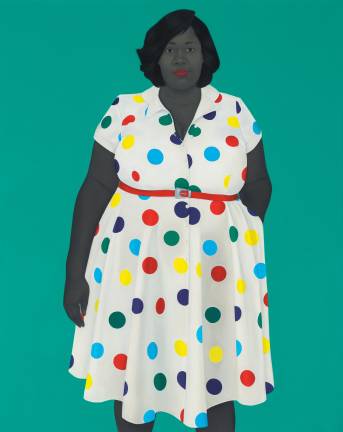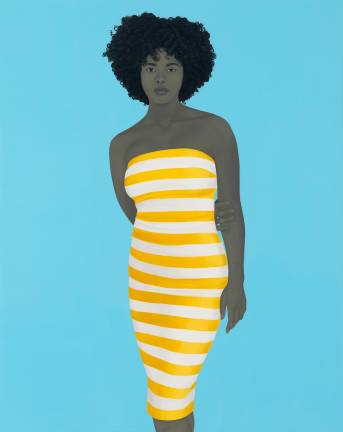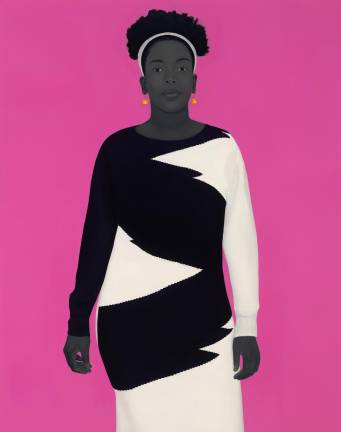Can a single work of art change the course of art history? Some have, but not many. For the individual viewer, the world can shift standing before a particular painting or sculpture, never to be seen the same way again. But only the passing of years will tell if an artist has altered the path widely or permanently.
Many felt such a seismic move when the official portraits of Barack and Michelle Obama were unveiled in 2018. Amy Sherald and Kehinde Wiley were the first African America artists commissioned to portray America's first family, the first black first family. Their paintings, worlds apart from any previous presidential portraits, made global headlines. Young, hip, confident, fresh, they were the kind of paintings most people would love to own, and how many presidential portraits can you say that about? Crowds flocked to the National Gallery.
New Yorkers have a chance to experience history-changing art right now. Wiley's equestrian sculpture "Rumors of War" has just arrived in Times Square. And Amy Sherald has an unforgettable show "the heart of the matter..." at Hauser & Wirth gallery in Chelsea, through October 26.
Sherald states, "I paint because I am looking for versions of myself in art history and in the world." Viewing her eight larger than life, evocative, elegant portraits of African Americans is moving, enlightening, uplifting, neuron-firing and deeply affecting.
Consider the Echoes
Since art is a personal journey, the best way to look at them is through your own lens. But here are some thoughts to consider. Sherald's relationship with art and literature is evident, wide, and deep. Consider what echoes she conjures. What might she be referencing, quoting, challenging, and changing? What might she hope to introduce as she creates conversations that cross centuries, cultures and art forms?
Several of the paintings' titles are derived from literary works. "When I let go of what I am, I become what I might be" - the title of a portrait of a young man with a flower in his lapel - is a saying attributed to Lao Tzu. "There is no charm equal to tenderness of heart," says Jane Austen's Emma. Sherald turns the phrase into the name of a painting of a young woman. "Sometimes the king is a woman," is a feminist mantra chalked on city streets by artist James de la Vega; here it titles a knockout painting of a woman wearing a black and white sweater dress against a hot pink background. "A single man in possession of a good fortune," is part of the opening sentence of Austen's "Pride and Prejudice." It's also the title of a portrait of a nattily dressed young man. What kinds of images might you imagine based on such titles, and what kinds does Sherald present?
The paintings are mostly three-quarter length, linking them to Rembrandt and a long tradition of society portraits. John Singer Sargent was commissioned by of titans of industry; for fun he painted the glamorous "Madame X," whose mysterious allure sizzles, as do Sherald's subject's. She chooses beautiful people and endows them with a cool self-assuredness, placing them against bright, candy-colored fields that recall Warhol, Lichtenstein and Pop Art. The faces of her subjects, painted in grisaille (connecting her work to artists as different as Kerry James Marshall and Jan van Eyck), gaze outward with a kind of take-it-or-leave-it pride, recalling both Grant Wood's "American Gothic" and Manet's "Olympia." Then she introduces visual delights through polka-dotted, striped, and patterned fabrics, much as Matisse or Klimt did. There are lots of echoes to find.
Straightforward Quotidian Beauty
The easiest visual quotation for viewers to catch is in the pose of a man sitting on a steel girder posed against a clear blue sky. Most New Yorkers have seen Charles C. Ebbets’ iconic 1932 photograph "Lunch atop a Skyscraper" (New York Construction Workers Lunching on a Crossbeam). Standing in front of Sherald's monumental painting, one feels a sense of flight, balanced by the poise of the subject seated at ease. "If you surrendered to the air, you could ride it” (the title is taken from Toni Morrison's "Song of Solomon") expresses a teetering thrill just before taking off. Where do these paintings take you?
Sherald has described the people in her paintings as "Americans doing everyday American things." Their straightforward quotidian beauty seems to be "the heart of the matter." The exhibition's text states that "she subverts the medium of portraiture to tease out unexpected narratives and situate black heritage centrally in the story of American art ... attempting to restore a broader, fuller picture of humanity."
Do these paintings deliver portraiture to new territories? Go and take a look. Decide for yourself if Sherald's creations have altered old ways of painting and of seeing. They did for me, and I can't wait to see what Amy Sherald will do next.
IF YOU GO
What: Amy Sherald "the heart of the matter..."
Where: Hauser & Wirth, 548 West 22nd St
When: Through October 26th




